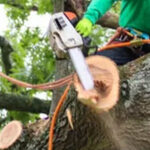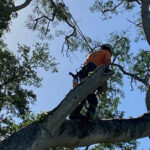As an arborist in the beautiful state of Florida, I’ve come across numerous tree issues that plague homeowners throughout the region. Florida’s unique climate and diverse flora create a set of challenges when it comes to maintaining healthy and vibrant trees.
In this blog post, I’ll shed light on some of the most common tree problems faced by homeowners in Florida and provide helpful insights on how to identify, prevent, and address these issues effectively. Let’s dive in!
-
Root Rot: The Silent Culprit
Root rot is a prevalent problem affecting trees in Florida, primarily due to the high humidity levels and heavy rainfall. This fungal infection attacks the tree’s roots, impeding its ability to absorb water and nutrients. Signs of root rot include yellowing leaves, stunted growth, and the presence of fungal growth near the base of the tree. To prevent root rot, ensure proper drainage around your trees and avoid overwatering. If you suspect root rot, consult a certified arborist who can recommend appropriate treatments.
-
Invasive Pests: Unwanted Guests
Florida’s warm climate attracts a variety of invasive pests that can wreak havoc on your trees. Two notorious pests are the Asian citrus psyllid, responsible for spreading citrus greening disease, and the emerald ash borer, known for attacking ash trees. Regularly inspect your trees for signs of infestation, such as wilting leaves, bark damage, or unusual holes. Implementing preventative measures like applying insecticides or introducing beneficial insects can help protect your trees from these harmful pests.
-
Hurricanes and Storm Damage
Living in Florida means being prepared for severe weather events, including hurricanes and tropical storms. These natural disasters pose a significant threat to trees, causing broken branches, uprooted trees, and structural damage. Regular tree maintenance, including pruning weak branches and removing deadwood, can improve your tree’s resilience to storms. If your tree suffers storm damage, consult a professional arborist to assess the extent of the injury and determine the best course of action.
-
Nutrient Deficiencies: Feeding Your Trees
Florida’s sandy soils often lack essential nutrients, leading to deficiencies in trees. Common nutrient deficiencies include iron, manganese, and magnesium. Symptoms may manifest as yellowing leaves, stunted growth, or leaf discoloration. Regularly fertilize your trees using a balanced, slow-release fertilizer specifically formulated for Florida’s soil conditions. A soil test conducted by an arborist can help identify specific nutrient deficiencies and guide your fertilization efforts.
-
Heat Stress: Surviving the Sweltering Summers
Florida’s scorching summer temperatures can take a toll on trees, causing heat stress. Symptoms include wilting leaves, browning foliage, and overall decline in tree health. To mitigate heat stress, provide adequate water during dry periods, especially for young and newly planted trees. Applying a layer of mulch around the base of your trees can help retain moisture and regulate soil temperatures. Consider providing temporary shade using shade cloth or a protective cover during the hottest months.
Conclusion
Maintaining healthy trees in Florida requires awareness of the unique challenges posed by the climate and environment. By staying vigilant and addressing common tree problems promptly, homeowners can ensure the longevity and beauty of their beloved trees. If you encounter any tree issues beyond your expertise, it’s always wise to consult a professional arborist who can provide guidance tailored to your specific situation. Remember, healthy trees contribute to the overall well-being of our environment and enhance the aesthetic appeal of our communities.
Contact us today to schedule a consultation and experience the difference of working with a reputable tree service provider.




